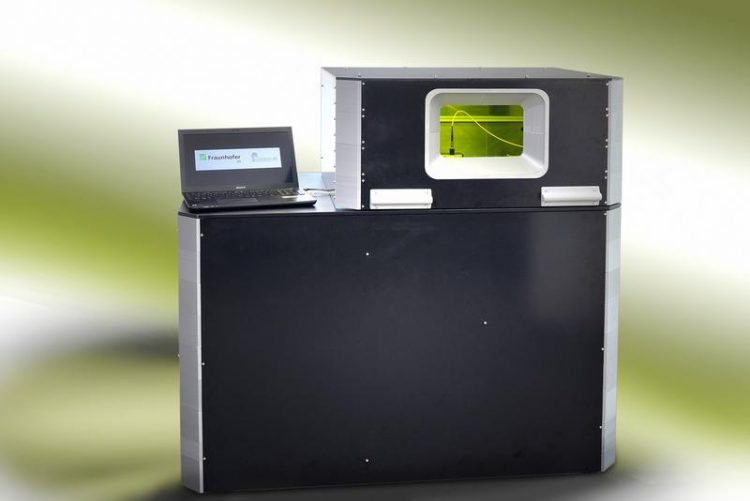formnext 2016: low-cost SLM unit with production costs below 20,000 euros

Picture 1: Debut at formnext 2016: the new, low-cost SLM unit for 3D printing of stainless steel components is particularly suitable for entry-level users. © Fraunhofer ILT, Aachen, Germany.
For major corporations, it is easy to make the move into additive manufacturing: they can hire specialists, invest in new and expensive plant, or establish new corporate divisions. German industry, however, is largely characterized by small and medium-sized enterprises (SMEs). Recent studies by the German Federal Ministry for Economic Affairs and Energy show that there is often still insufficient awareness among SMEs of the potential of additive manufacturing and the opportunities it offers. To some extent, training in it even fails to address the needs of SMEs.
Smoother access to 3D printing
This is where the Aachen Center for 3D Printing comes in. It was established by FH Aachen in conjunction with Fraunhofer ILT in 2014. “Our group of experts works closely together to give medium-sized companies access to 3D printing,” says the center’s director, Prof. Gebhardt. The new center offers companies additive manufacturing training courses, advice, and services covering component design, manufacturing, and finishing processes.
With SMEs also keen to utilize new technology as they seek to develop in-house expertise, a collaborative project has developed a low-cost unit for selective laser melting (SLM). Employing a Cartesian coordinate system, this first functional prototype uses a 140 W laser diode with a focus diameter of 250 µm to produce complex metal components with a maximum height of 90 mm and a maximum
Ideal for entry-level users
A unit with a comparable installation space costs at least 100,000 euros, according to Dawid Ziebura, a project engineer at Fraunhofer ILT. He thinks the low-cost SLM unit will have a price tag of 30,000 euros. Factors in its favor are that entry-level users need only a few hours to learn how to operate it, and that it is easy to use. All of the components in the unit allow users to maintain the unit themselves, and are easy to replace. “The low-cost unit makes it easy for entry-level users getting into 3D printing of metal components,” Ziebura says.
The components that the unit can produce are suitable for many typical SLM applications, ranging from prototypes and sample parts to functional components. Users themselves decide the speed and the production quality at which the unit operates. It can, for instance, produce a medium-sized (55 cm³), stainless steel part (grade 1.4404) at a density of more than 99.5% within 12 hours. In addition, the unit offers the option of producing lattice structures for large-volume areas in order to shorten the construction time of less stressed areas. Selecting a lattice density of 20% (corresponding to 20% of the original volume) reduces construction time by 60%. The engineers in Aachen now want to shorten process times and optimize exposure strategies in order to improve component quality. What is more, they are planning to 3D print components made of aluminum alloys and tool steel.
Demonstration at formnext 2016
At formnext in Frankfurt am Main from November 15-18, 2016, prospective buyers can visit the Fraunhofer booth to see the new, low-cost SLM unit in action: Hall 3.1, Booth E60.
Contact
Prof. Dr.-Ing. Andreas Gebhardt
Aachen Center for 3D Printing
FH Aachen, University of Applied Sciences
Phone +49 241 6009 52500
gebhardt@fh-aachen.de
FH Aachen University of Applied Sciences
Goethestraße 1
52064 Aachen, Germany
M. Eng. Dawid Ziebura
Rapid Manufacturing Group
Phone +49 241 8906-8172
dawid.ziebura@ilt.fraunhofer.de
Dipl.-Wirt.-Ing. Sebastian Bremen
Rapid Manufacturing Group
Phone +49 241 8906-537
sebastian.bremen@ilt.fraunhofer.de
Fraunhofer Institute for Laser Technology ILT,
Steinbachstr. 15
52074 Aachen, Germany
http://www.ilt.fraunhofer.de/en.html
https://www.fh-aachen.de/en/
Media Contact
All latest news from the category: Trade Fair News
Newest articles

Witness Groundbreaking Research on Achilles Tendon Recovery
Achilles tendon injuries are common but challenging to monitor during recovery due to the limitations of current imaging techniques. Researchers, led by Associate Professor Zeng Nan from the International Graduate…

Why Prevention Is Better Than Cure—A Novel Approach to Infectious Disease Outbreaks
Researchers have come up with a new way to identify more infectious variants of viruses or bacteria that start spreading in humans – including those causing flu, COVID, whooping cough…

Durable, Efficient, Sustainable: The Rise of Cerium Oxide Thermal Switches
Groundbreaking cerium oxide-based thermal switches achieve remarkable performance, transforming heat flow control with sustainable and efficient technology. Cerium Oxide-Based Thermal Switches Revolutionize Heat Flow Control Thermal switches, which electrically control…



